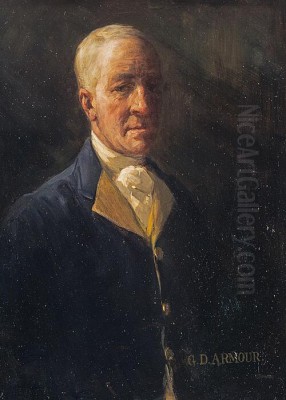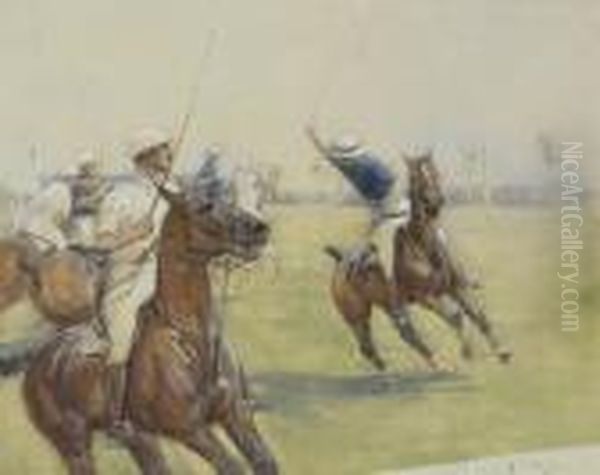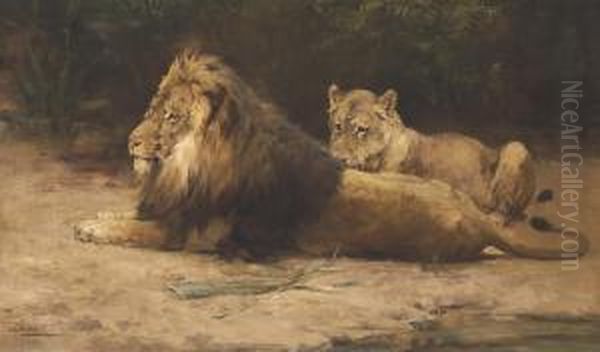
George Denholm Armour, often signing his work as G. D. Armour, stands as a significant figure in British art, particularly celebrated for his evocative depictions of sporting life, animals, and his skillful illustrations. His career spanned the late Victorian era through to the mid-20th century, a period of considerable change in both the art world and society. Armour carved a distinct niche for himself, becoming one of the preeminent equestrian and sporting artists of his generation, his work imbued with a vitality and authenticity born from personal experience and keen observation.
Early Life and Artistic Awakening
Born on January 30, 1864, in Waterside, Lanarkshire, Scotland, George Denholm Armour's early life provided a foundation for his later artistic pursuits. Though Scottish by birth, he spent a significant part of his childhood in Liverpool, a bustling English port city, which would have exposed him to a different societal dynamic compared to his native Lanarkshire. His formal education continued in Fife, Scotland, suggesting a return to his Scottish roots for schooling.
The call to art led him to the esteemed Edinburgh College of Art. Here, he would have received rigorous training in drawing, painting, and composition, laying the technical groundwork for his future career. The Edinburgh College of Art was a crucible for many talented Scottish artists, and Armour's time there would have immersed him in a vibrant artistic environment. Further intellectual development was pursued at the University of St Andrews, an ancient and respected institution. This combination of practical art training and broader university education equipped Armour with both the skills and the intellectual curiosity that would define his work.
The Lure of Morocco and Formative Experiences
A pivotal period in Armour's early career was his time spent in Tangier, Morocco. In the late 19th century, Tangier was an exotic and alluring destination for many European and American artists, drawn by its vibrant culture, unique light, and different way of life. For Armour, Tangier was not just a place to paint; it was an adventure. He immersed himself in the local scene, notably participating in fox-hunting expeditions.

It was in Tangier that he formed a significant association with Joseph Crawhall III (1861-1913), one of the leading figures of the Glasgow Boys. Crawhall, known for his exceptional ability to capture animals and birds with minimalist brilliance, often in watercolour on linen, shared Armour's passion for animals and outdoor life. Their time together in Tangier, sharing artistic pursuits and the thrill of the hunt, was undoubtedly influential for Armour. The experience of painting in the clear North African light and observing animals in a different environment would have broadened his artistic palette and observational skills. Artists like Arthur Melville (1855-1904), another prominent Scottish painter associated with the Glasgow Boys and known for his Orientalist watercolours, also found inspiration in the exotic locales of North Africa and Spain, and Armour's experiences resonate with this wider artistic trend.
London, Studios, and Establishing a Career
After his formative experiences abroad, Armour eventually settled in London, the epicentre of the British art world. This move was crucial for any artist seeking wider recognition and patronage. In London, he became part of the artistic community, and one notable association was with the Primrose Hill Studios. This artists' colony, active in North London, provided a space for creative exchange and collaboration.
During his time there, or in similar artistic circles, Armour interacted with prominent figures. The provided information mentions a collaboration with "Phoebe Mason," though it is possible this refers to, or he was certainly aware of, the highly influential illustrator Phil May (1864-1903), his exact contemporary, renowned for his economic line and witty social commentary in publications like Punch. Armour also shared studio space or was a contemporary of John William Waterhouse (1849-1917), a celebrated painter known for his Pre-Raphaelite and classical themed works, particularly his depictions of women from myth and legend. Armour, in his 1937 autobiography Bridle and Brush: Reminiscences of an Artist Sportsman, recalled his time at Primrose Hill Studios between 1878 and 1900, sharing memories of Waterhouse. Other artists associated with Primrose Hill Studios around this period included William Logsdail (1859-1944), known for his realistic London street scenes and later portraits, and Maurice Greiffenhagen (1862-1931), a painter and illustrator who also designed iconic posters.
Master of Equestrian and Sporting Art
Armour's true metier, and where his reputation was firmly established, was in the realm of sporting art, particularly subjects involving horses and hunting. His deep understanding of equine anatomy, movement, and character allowed him to depict horses with remarkable accuracy and vitality. Whether it was the dynamic energy of a polo match, the focused intensity of a hunt, or the quiet companionship between horse and rider, Armour captured the essence of the equestrian world.

His paintings often featured hounds as well, rendered with the same keen eye for detail and personality. Works like "A Westhighland Terrier and a Dachshund" demonstrate his affection and skill in portraying canine subjects. His passion for these themes was not merely academic; Armour was an accomplished horseman himself. This firsthand experience lent an authenticity to his work that resonated with fellow enthusiasts and art collectors alike. His painting "Polo Match," which was notably auctioned at Christie's in 1988, exemplifies his ability to convey the speed and excitement of the sport.
In this field, he was a contemporary of other great British sporting artists. Sir Alfred Munnings (1878-1959) was perhaps the most famous equestrian artist of the era, known for his vigorous portrayals of racehorses, hunting scenes, and rural life. Lionel Edwards (1878-1966) was another prolific and highly respected painter and illustrator of hunting and coaching scenes, whose career significantly overlapped with Armour's. Cecil Aldin (1870-1935), famous for his charming depictions of dogs, especially terriers, and his lively hunting and coaching prints, also shared a similar thematic interest. Armour's work, while fitting within this tradition, possessed its own distinct character, marked by a certain elegance and a sensitive understanding of his subjects.
The Illustrator's Craft: Bringing Books to Life
Beyond his easel paintings, George Denholm Armour was a highly sought-after illustrator. His drawings and watercolours graced the pages of numerous books, particularly those focused on sport, natural history, and country life. His illustrations were not mere decorations but integral components that enhanced the reader's experience, bringing the text to life with visual flair.
One of his significant early illustration projects was for E.D. Cuming's British Sport Past and Present (1907, with some sources citing 1909). This work allowed him to showcase his versatility in depicting various sporting activities. In 1908, he provided memorable colour illustrations for a new edition of R.S. Surtees' classic Hunts with Jorrocks, capturing the humour and spirit of Surtees' beloved character. The tradition of sporting illustration was rich, with earlier artists like Randolph Caldecott (1846-1886) having set a high standard for lively and characterful depictions of rural and sporting life.
Armour's own publication, A Hunting Alphabet (1929), further demonstrated his mastery of this genre, combining his artistic skill with his intimate knowledge of hunting. He also collaborated with fellow Scottish artist Edwin Alexander (1870-1926), who was, like Joseph Crawhall, known for his exquisite studies of birds and animals, to illustrate a 1919 edition of Charles St John's Wild Sports & Natural History of the Highlands. This collaboration highlights the collegial relationships Armour maintained within the artistic community. His illustrative style was characterized by fluid lines, an excellent sense of movement, and often, a subtle humour.
War Service, Later Life, and Autobiography
The outbreak of the First World War saw Armour contribute his equestrian expertise to the war effort. He served as a remount officer, tasked with procuring and training horses for the army, a crucial role in an era when cavalry and horse-drawn transport were still vital. His service took him to Salonika (Thessaloniki, Greece), a challenging theatre of war. Prior to this, Armour had even studied military equitation at the prestigious Spanish Riding School in Vienna, a testament to his dedication to horsemanship. These experiences undoubtedly deepened his understanding of horses under various conditions.
In his later years, Armour continued to paint and illustrate. A significant contribution to the understanding of his life and work came with the publication of his autobiography, Bridle and Brush: Reminiscences of an Artist Sportsman, in 1937. This book provides invaluable insights into his artistic journey, his encounters with other artists like Waterhouse, his sporting adventures, and his views on art and life. Such memoirs are precious resources for art historians, offering a personal perspective on a bygone era.
His personal life included his marriage in 1893 to Mary Emma Robb, the daughter of John Robb, J.P. This union provided a stable backdrop to his professional career. George Denholm Armour passed away in 1949, leaving behind a substantial body of work that continues to be admired for its skill and charm. His dedication to his chosen subjects remained steadfast throughout his long career.
Artistic Style, Techniques, and Thematic Consistency
George Denholm Armour's artistic style is characterized by its confident draughtsmanship, keen observational skills, and an ability to capture movement and atmosphere. He was proficient in several mediums, though he is particularly noted for his watercolours and etchings. His watercolours often display a fresh, spontaneous quality, with a good sense of colour and light, likely honed during his time in Tangier and his commitment to outdoor sketching.
His etchings reveal a mastery of line and an ability to create rich tonal variations. Whether depicting the sleek musculature of a racehorse, the shaggy coat of a terrier, or the dynamic interplay of figures in a hunting scene, Armour's work consistently demonstrates a deep understanding of anatomy and a feel for the character of his subjects. Works like "A Desert Celebration" or "Lion and Lioness" (though less typical than his sporting scenes, these titles suggest a breadth of animal subjects) would have showcased this understanding.
There is a narrative quality to much of his work, especially his illustrations, where he effectively tells a story or captures a specific moment with clarity and impact. Unlike some of his contemporaries who might have leaned towards more impressionistic or modernist styles, Armour remained largely within a representational tradition, focusing on accuracy and evocative portrayal. His art was not about radical experimentation but about perfecting the depiction of the world he knew and loved – the world of sport, animals, and the British countryside.
Contemporaries, Collaborations, and Artistic Milieu
Armour's career unfolded within a rich and diverse artistic landscape. His association with Joseph Crawhall connects him to the innovative spirit of the Glasgow Boys, a group that included figures like James Guthrie (1859-1930) and E.A. Walton (1860-1922). While Armour may not be classified as a core member, he shared their commitment to realism, their interest in rural subjects, and often, their preference for working en plein air.
His collaboration with Edwin Alexander on Wild Sports & Natural History of the Highlands underscores a shared Scottish heritage and a mutual respect for each other's skill in animal portrayal. In London, his path crossed with academic painters like John William Waterhouse and illustrators who were shaping popular visual culture, such as Phil May. The art world of the late 19th and early 20th centuries was a complex web of societies, exhibitions, and personal connections. Armour exhibited his work, including at the Royal Scottish Academy from as early as 1887, indicating his early engagement with the formal art establishment. He was also made an honorary member of the Meadowbrook Polo Club in 1913, a nod to his standing in the equestrian community.
The competitive landscape for sporting artists was robust, with artists like Munnings and Edwards achieving great fame. Armour held his own in this field, his work distinguished by its refined quality and perhaps a more intimate, less grandiose portrayal of sporting life compared to some of his peers. He was part of a tradition of British sporting art that stretched back to George Stubbs (1724-1806) and beyond, adapting it to the tastes and sensibilities of his own time.
Legacy and Collections: Enduring Appeal
George Denholm Armour's legacy is that of a dedicated and highly skilled artist who captured a specific facet of British life with enduring charm and authenticity. His work continues to be sought after by collectors of sporting art and illustration. His paintings and prints evoke a sense of nostalgia for a bygone era of country pursuits, but their appeal also lies in their timeless depiction of the bond between humans and animals, and the beauty of the natural world.
His works are held in several public collections, a testament to his recognized artistic merit. These include the Kelvingrove Art Gallery and Museum in Glasgow, the National Galleries of Scotland, and the University of Edinburgh. Internationally, his art can be found in significant collections such as the Paul Mellon Collection at the Yale Center for British Art, which houses a renowned collection of British sporting art. The presence of his work in these institutions ensures its accessibility to future generations and its continued study by art historians.
His illustrations, preserved in the books they adorn, also form an important part of his legacy, having introduced countless readers to his vision of the sporting world. Through both his fine art and his illustrative work, Armour made a distinctive contribution to British art.
Conclusion: An Artist of Field and Studio
George Denholm Armour was more than just a painter of horses and hounds; he was a chronicler of a way of life, an artist whose passion for his subjects shone through in every brushstroke and every line. From the Scottish landscapes of his youth to the sun-drenched plains of Morocco and the bustling art scene of London, his experiences shaped a unique artistic vision. His collaborations with artists like Joseph Crawhall and Edwin Alexander, and his shared studio time with figures like John William Waterhouse, place him firmly within the artistic currents of his time.
His dedication to mastering the depiction of animals, particularly horses, in motion and at rest, combined with his skill as an illustrator for popular books, secured him a lasting reputation. While perhaps not as revolutionary as some of his modernist contemporaries, Armour excelled in his chosen field, creating a body of work that is both aesthetically pleasing and historically significant. He remains a beloved figure for those who appreciate the rich tradition of British sporting art and the enduring allure of the equestrian world. His life, as detailed in Bridle and Brush, was one lived with enthusiasm for both art and adventure, a spirit that continues to animate his work today.